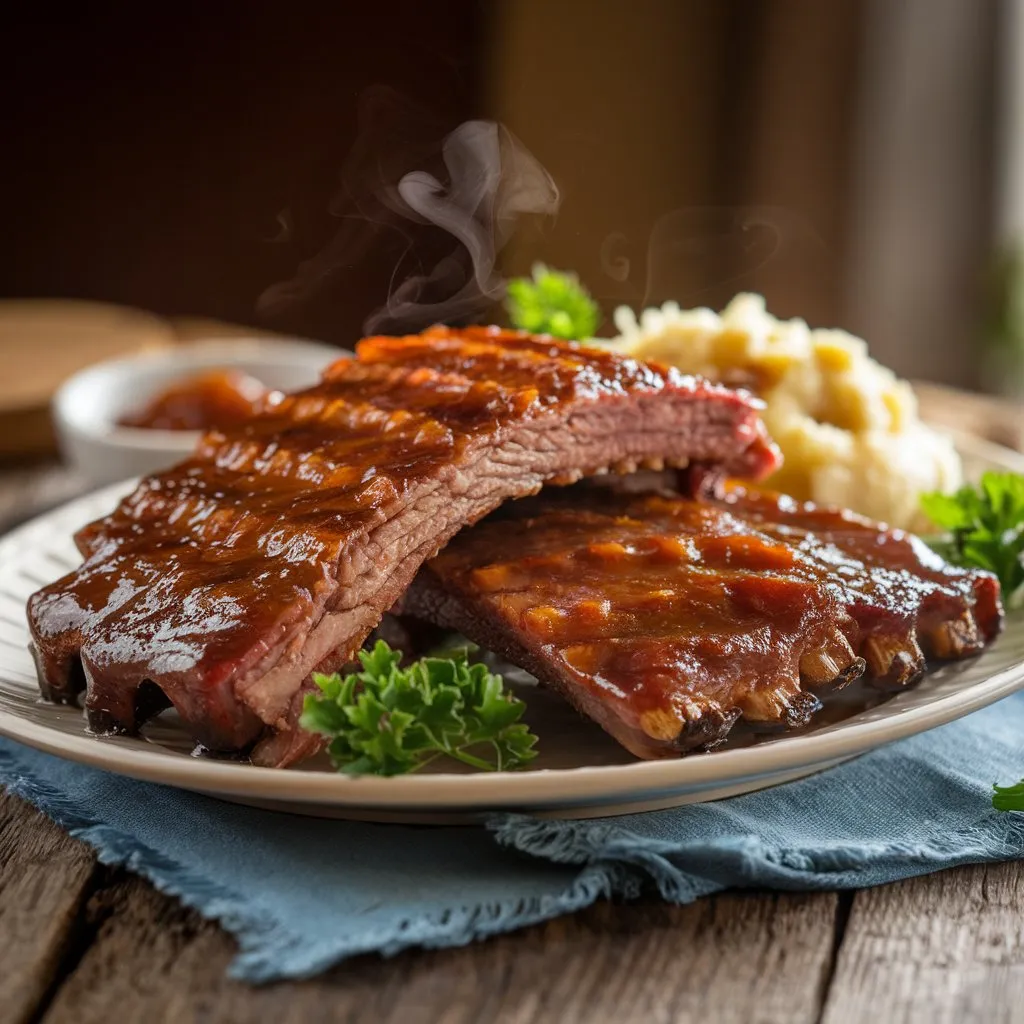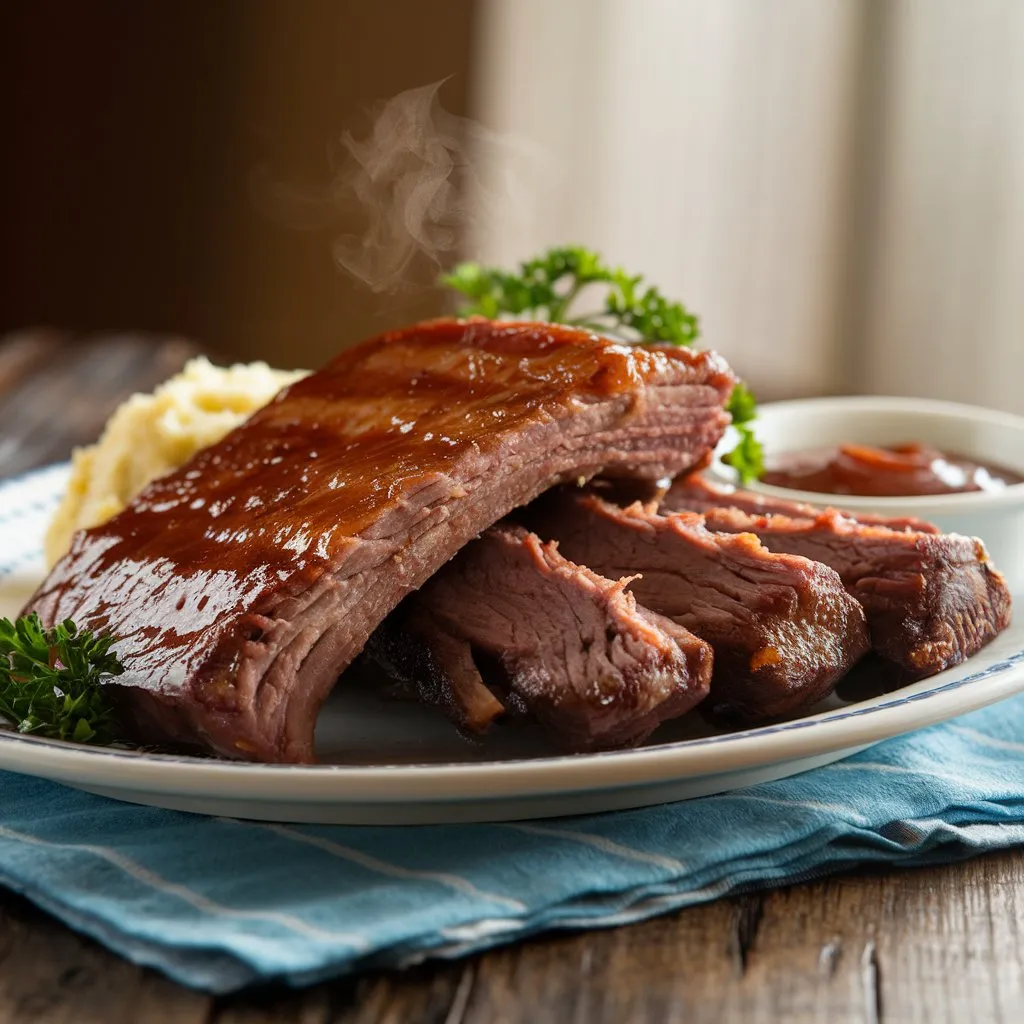Table of Contents
Introduction to Boneless Beef Ribs
When it comes to hearty, mouthwatering meals, few dishes rival the appeal of perfectly cooked beef ribs. But what if you could skip the hassle of dealing with bones and still enjoy all the tender, juicy goodness? That’s where boneless beef ribs cooked in oven shine! This guide will walk you through every step to ensure your ribs are flavorful, tender, and melt-in-your-mouth delicious.
Whether you’re cooking for a cozy dinner at home or wowing guests at a weekend gathering, this foolproof recipe will become your go-to. Let’s dive into the art and science of cooking boneless beef ribs in oven!
What Are Boneless Beef Ribs?
Contrary to their name, boneless beef ribs aren’t ribs at all! They are typically cut from the chuck or shoulder area of the cow. These cuts are meaty and flavorful, offering all the rib-like texture without the bones. The lack of bones makes them versatile and easier to prepare, especially in the oven.
Fun fact: Boneless beef ribs are sometimes labeled as “country-style ribs,” though the exact naming varies depending on your butcher or store.
Why Choose Boneless Beef Ribs?
So, why opt for boneless beef ribs over their bone-in counterparts? Here are a few compelling reasons:
- Ease of Preparation: No bones to cut around, making them simpler to handle.
- Uniform Cooking: Without bones, heat distributes evenly for consistent results.
- Budget-Friendly: They’re often more affordable than traditional beef ribs.
- Customizable Flavors: Boneless beef ribs readily absorb marinades and seasonings.
In short, these ribs combine convenience with mouthwatering potential, making them a winner for home cooks.
Choosing the Best Boneless Beef Ribs
Before you even preheat your oven, the secret to amazing boneless beef ribs lies in picking the right cut of meat.
Selecting Quality Meat at the Store
- Look for Marbling: Fat equals flavor! Choose ribs with visible streaks of fat for the juiciest results.
- Avoid Excess Fat: While marbling is good, large chunks of fat can lead to uneven cooking.
- Freshness Is Key: Opt for meat that’s bright red and free of any unpleasant odors.
- Ask the Butcher: Don’t hesitate to ask your butcher for advice on the best boneless cuts.
Prepping the Ribs Before Cooking
Once you’ve chosen your ribs, preparation is critical:
- Trim Excess Fat: Use a sharp knife to remove any large fat pieces that won’t render during cooking.
- Pat Them Dry: Moisture on the surface can prevent a proper sear or crust.
- Season Generously: Ribs love bold flavors, so don’t skimp on your marinade or rub.
Remember, the goal is to enhance the natural flavors of the beef while creating a rich, caramelized exterior.
The Science Behind Oven-Cooking Ribs
There’s something magical about slow-cooking ribs in the oven. The gentle heat breaks down tough connective tissues, transforming them into tender bites of heaven. Let’s explore why this method works so well.
Why Oven Cooking Works for Ribs
- Consistent Heat: The oven provides a steady temperature, ensuring even cooking.
- Controlled Environment: Unlike grilling, you can control every aspect, from temperature to moisture.
- Convenient Setup: No need for special equipment or constant monitoring.
Benefits of Slow Cooking in Oven
- Tender Texture: Low and slow cooking breaks down collagen into gelatin, creating melt-in-your-mouth tenderness.
- Enhanced Flavor: Long cooking times allow marinades and rubs to penetrate deeply.
- Juicy Results: Retaining moisture is easier in a closed oven environment, especially with a foil wrap or covered dish.
So, if you’ve ever wondered why oven-baked ribs are so satisfying, now you know: it’s science!
Preparing the Marinade or Dry Rub
The flavor journey begins with a stellar marinade or dry rub. Whether you prefer a savory blend, a spicy kick, or a sweet-and-tangy glaze, the choice is yours. Here’s how to get started:
Simple Ingredients for a Flavorful Rub
A good rub balances salt, sweet, and spice. Here’s a basic recipe to build on:
- Brown sugar (2 tbsp): Adds sweetness and helps caramelization.
- Smoked paprika (1 tbsp): For a smoky depth.
- Garlic powder (1 tsp): Essential for savory notes.
- Onion powder (1 tsp): Enhances the beefy flavor.
- Cayenne pepper (½ tsp): Optional, for a bit of heat.
- Kosher salt and black pepper (to taste).
Combine these ingredients in a bowl and mix thoroughly.
Pro Tip: For a marinade, combine the above with olive oil, soy sauce, and a splash of vinegar. Let the ribs soak in it for at least 2 hours or overnight for best results.

How Long to Marinate?
Marination time depends on your schedule:
- Quick option: 30 minutes to 1 hour.
- Optimal flavor: 4 to 6 hours in the fridge.
- Maximum infusion: Overnight (8–12 hours).
If using a dry rub, apply it generously and let the ribs sit at room temperature for 20–30 minutes before cooking to allow the flavors to meld.
Preheating and Setting Up the Oven
Consistency in temperature is crucial when oven-cooking ribs. Follow these steps to ensure a smooth cooking process:
- Preheat the Oven: Set it to 300°F (150°C) for slow cooking.
- Choose the Right Pan: Use a roasting pan or baking dish with a deep base to catch any drippings.
- Foil Is Your Friend: Line the pan with aluminum foil for easy cleanup and wrap the ribs tightly to lock in moisture.
Pro Tip: Placing a wire rack in the pan helps the ribs cook evenly, allowing heat to circulate.
Cooking the Ribs: Slow and Steady Wins the Race
Cooking boneless beef ribs is all about patience. Here’s the breakdown:
Optimal Temperature and Timing
- Cover and Cook: Place the ribs in the preheated oven, wrapped tightly in foil. Cook for 2–2.5 hours at 300°F.
- Uncover and Baste: After the initial cooking time, uncover the ribs, baste them with juices or glaze, and return them to the oven for 15–20 minutes.
- Caramelize the Top: For an irresistible crust, turn the oven to broil and cook the ribs for an additional 5 minutes.
Checking for Doneness
Wondering how to tell if your ribs are perfectly cooked? Use these indicators:
- Internal Temperature: A meat thermometer should read 190°F (88°C) for fork-tender ribs.
- Texture Test: Insert a fork; the ribs should easily pull apart.
- Appearance: The surface should be caramelized and slightly crispy.
Block Quote: “The secret to perfect ribs is patience. Don’t rush the process—low and slow cooking brings out their best.”
Common Problems and Solutions When Cooking Ribs
Even the best cooks encounter issues. Here are the most common problems and how to fix them:
Ribs Turn Out Too Tough
- Cause: Undercooked meat; collagen hasn’t fully broken down.
- Solution: Wrap the ribs in foil and return them to the oven at 300°F for an additional 30 minutes.
Ribs Are Too Dry
- Cause: Overcooking or lack of moisture.
- Solution: Baste the ribs frequently during the uncovered phase and add a small dish of water to the oven to create steam.
Overcooking or Undercooking Issues
- Cause: Inconsistent oven temperature.
- Solution: Always preheat your oven and use a thermometer to monitor the internal temperature of the ribs.
Serving Suggestions and Side Dishes
No meal is complete without the perfect sides to accompany your tender, flavorful boneless beef ribs. Here are some classic and creative ideas to elevate your dish.
Perfect Pairings for Boneless Beef Ribs
- Mashed Potatoes
- Creamy, buttery mashed potatoes balance the rich flavors of the ribs. Add garlic or cheddar cheese for an extra twist.
- Coleslaw
- A crunchy, tangy slaw cuts through the fattiness of the ribs, adding a refreshing contrast.
- Cornbread
- Sweet, crumbly cornbread pairs beautifully with savory ribs and can soak up any extra juices.
- Grilled Vegetables
- Charred asparagus, zucchini, or bell peppers complement the smoky flavors of the ribs.
- Baked Beans
- This classic barbecue side adds a hearty, slightly sweet note to the meal.
Presentation Tips for a Gourmet Meal
- Slice the ribs into individual portions for an elegant look.
- Drizzle with a bit of glaze or sauce for added shine and visual appeal.
- Garnish with fresh herbs like parsley or thyme for a pop of color.
- Serve on a wooden board or platter to create a rustic, homestyle vibe.
Variations and Enhancements to the Recipe
For those looking to spice things up, here are some creative ways to put your own spin on oven-cooked boneless beef ribs.
Adding a Smoky Flavor Without a Grill
Miss the smoky essence of grilled ribs? Try this:
- Liquid Smoke: Add a few drops to your marinade or rub for that char-grilled aroma.
- Smoked Spices: Use smoked paprika or chipotle powder to infuse smokiness directly into the ribs.
Sweet and Spicy Glaze Ideas
A good glaze can take your ribs to the next level. Here are two foolproof options:
- Honey-Chipotle Glaze
- Mix honey, chipotle peppers in adobo, and a splash of lime juice for a sweet heat.
- Maple-Bourbon Glaze
- Combine maple syrup, a dash of bourbon, and Dijon mustard for a smoky-sweet coating.
Apply the glaze during the last 15 minutes of cooking, and baste frequently for a sticky, caramelized finish.
FAQs About Boneless Beef Ribs in Oven
To round things out, here are answers to some of the most common questions about cooking boneless beef ribs in the oven.
Can I Use Frozen Ribs?
Yes, but it’s best to thaw them first for even cooking. If you’re short on time:
- Defrost in the microwave on the defrost setting.
- Cook directly from frozen, adding an extra 30–45 minutes to the total cooking time.
How Do I Store Leftovers?
Store any leftover ribs in an airtight container in the fridge for up to 3–4 days. For longer storage, freeze them for up to 3 months.
- Reheating Tip: Warm in the oven at 275°F (135°C) covered in foil with a splash of water or broth to prevent drying out.
Are Boneless Ribs Healthier Than Bone-In?
While bone-in ribs are comparable in calories, boneless ribs often have more meat per serving. Their healthiness depends on your cooking method and portion size. Opt for lean cuts and bake rather than fry for a healthier meal.
Block Quote: “The versatility of boneless beef ribs makes them perfect for experimenting. Add your own twist and make them unforgettable!”
Conclusion: Your Foolproof Method for Delicious Boneless Beef Ribs
Cooking boneless beef ribs in oven is a culinary adventure that combines simplicity with sensational results. With a bit of preparation and patience, you can transform an affordable cut of meat into a tender, flavorful masterpiece. Whether you stick to the classic recipe or experiment with glazes and sides, this dish is sure to impress family and friends alike.
Remember, the keys to success are:
- Choosing high-quality meat.
- Using a flavorful marinade or rub.
- Cooking low and slow for maximum tenderness.
So, preheat that oven, grab your favorite spices, and get ready to savor every bite of these melt-in-your-mouth boneless beef ribs. Your kitchen is about to smell amazing, and your taste buds will thank you! 🍖🔥

